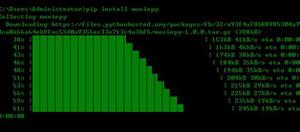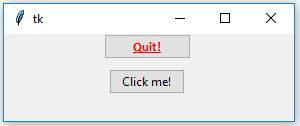python日志模块logging

1. 基础用法
python提供了一个标准的日志接口,就是logging模块。日志级别有DEBUG、INFO、WARNING、ERROR、CRITICAL五种(级别依次升高),分别对应的函数为debug()、info()、warning()、error()、critical()。
>>> import logging>>> logging.debug("ni hao")
>>> logging.info("ni hao2")
>>> logging.warning("ni hao")
WARNING:root:ni hao
>>> logging.error("ni hao")
ERROR:root:ni hao
>>> logging.critical("ni hao")
CRITICAL:root:ni hao
>>>
可以发现debug()和info()方法没有显示任何信息,这是因为默认的日志级别是WARNING,所以低于此级别的日志不会记录。
可以利用函数basicCinfig修改日志级别
>>> import logging>>> logging.basicConfig(level=logging.INFO)
>>> logging.info("nihao")
INFO:root:nihao
>>> logging.debug("dfasl")
>>> logging.basicConfig(level=logging.DEBUG)
>>> logging.info(4)
INFO:root:4
>>>
basicConfig()函数还可以定义更多的内容,如
logging.basicConfig(format=log_format,datefmt='%Y-%m-%d %H:%M:%S %p',level=logging.DEBUG)
举例
import logginglog_format = '%(filename)s %(funcName)s %(asctime)s %(message)s'
log_filename = "logging_test.log"
logging.basicConfig(filename=log_filename, format=log_format, datefmt='%Y-%m-%d %H:%M:%S:%S %p', filemode='w', level=logging.INFO)
logging.warning("warning###########")
logging.warning("error@@@@@@@@@@@@@@")
logging.error("error~~~~~~~~~~~~~~~~")
结果(输出文件“logging_test.log”内容)
del.py <module> 2015-04-30 16:29:02:02 PM warningdel.py <module> 2015-04-30 16:29:02:02 PM error
del.py <module> 2015-04-30 16:29:02:02 PM error
logging.basicConfig函数各参数
filename: 指定日志文件名filemode: 和file函数意义相同,指定日志文件的打开模式,'w'或'a'
format: 指定输出的格式和内容,format可以输出很多有用信息,如上例所示:
%(levelno)s: 打印日志级别的数值
%(levelname)s: 打印日志级别名称
%(pathname)s: 打印当前执行程序的路径,其实就是sys.argv[0]
%(filename)s: 打印当前执行程序名
%(funcName)s: 打印日志的当前函数
%(lineno)d: 打印日志的当前行号
%(asctime)s: 打印日志的时间
%(thread)d: 打印线程ID
%(threadName)s: 打印线程名称
%(process)d: 打印进程ID
%(message)s: 打印日志信息
datefmt: 指定时间格式,同time.strftime()
level: 设置日志级别,默认为logging.WARNING
stream: 指定将日志的输出流,可以指定输出到sys.stderr,sys.stdout或者文件,默认输出到sys.stderr,当stream和filename同时指定时,stream被忽略
注:日志的设置是使用basicConfig()方法,日志写入文件的默认方式是‘a’,即“追加”,如果想覆盖文件,使用filemode='w'。
logging模块的功能非常强大,可以通过更加自由的接口,自定义出更复杂的日志形式。需要用到下面3种对象logger、formatter、handler 。以下介绍logger
2. logger
logger对象直接提供日志接口。
通过handler对象可以把日志内容写到不同的地方。
例:将日志同时输出到文件和屏幕
#coding: utf-8import logging
logger = logging.getLogger()
logger.setLevel(logging.DEBUG)
formatter = logging.Formatter('%(asctime)s - %(name)s - %(levelname)s - %(message)s')
fh = logging.FileHandler("test.log")
ch = logging.StreamHandler()
fh.setFormatter(formatter)
ch.setFormatter(formatter)
logger.addHandler(fh) #可以设置addHandler添加内容(fh、ch、fh+ch),从而设置输出位置
logger.addHandler(ch)
logger.error("error$$$$$$$$$$")
logger.debug("aaaaa**********")
3. 模块
#! /usr/bin/env python# --*-- coding:utf-8 --*--
import os
import logging
import logging.handlers
LOGGER = logging.getLogger(__name__)
def init_logger():
log_file_path = './'
LOGGER.setLevel(logging.INFO)
ch = logging.StreamHandler()
ch.setLevel(logging.INFO)
formatter = logging.Formatter("%(asctime)s %(levelname)s %(filename)s(%(lineno)d) %(message)s ",
"%Y-%m-%d %H:%M:%S")
ch.setFormatter(formatter)
LOGGER.addHandler(ch)
log_dir = os.path.dirname(log_file_path)
if not os.path.isdir(log_dir):
os.makedirs(log_dir)
cur_date = datetime.datetime.now().strftime('%Y-%m-%d')
file_name = os.path.join(log_file_path, 'consume_kafka-%s.log' % cur_date)
fh = logging.handlers.RotatingFileHandler(file_name, maxBytes=10 * 1024 * 1024, backupCount=9)
fh.setLevel(logging.INFO)
fh.setFormatter(formatter)
LOGGER.addHandler(fh)
注:logging.handlers.RotatingFileHandler
这个Handler可以管理文件大小。当文件达到一定大小之后,它会自动将当前日志文件改名,然后创建一个新的同名日志文件继续输出。比如日志文件是chat.log。当chat.log达到指定的大小之后,RotatingFileHandler自动把文件改名为chat.log.1。不过,如果chat.log.1已经存在,会先把chat.log.1重命名为chat.log.2。最后重新创建 chat.log,继续输出日志信息。【这样保证了chat.log里面是最新的日志】它的构造函数是:
RotatingFileHandler(filename[, mode[, maxBytes[, backupCount]]])
其中filename和mode两个参数和FileHandler一样。
maxBytes用于指定日志文件的最大文件大小。如果maxBytes为0,意味着日志文件可以无限大,这时上面描述的重命名过程就不会发生。
backupCount用于指定保留的备份文件的个数。比如,如果指定为2,当上面描述的重命名过程发生时,原有的chat.log.2并不会被更名,而是被删除。
以上是 python日志模块logging 的全部内容, 来源链接: utcz.com/z/387663.html






